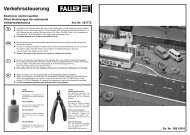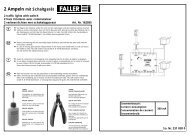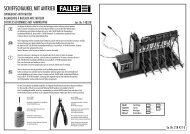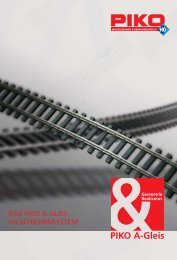INSTRUCTION MANUAL
INSTRUCTION MANUAL
INSTRUCTION MANUAL
You also want an ePaper? Increase the reach of your titles
YUMPU automatically turns print PDFs into web optimized ePapers that Google loves.
Decoder MX620 - MX622, MX630 - MX632 Sound Decoder MX640 - MX648 Page 17<br />
Tweaking the motor regulation<br />
setting would be CV #57 = 140…150.<br />
CV #57 = 0: automatically adjusts to the track voltage<br />
(relative reference); only useful with stabilized track<br />
voltage.<br />
The motor’s performance, especially at crawling speeds (as jerk-free as possible), can be fine-tuned<br />
with the following CV’s:<br />
CV #9 – Motor control frequency and EMF sampling rate<br />
The motor is controlled by pulse with modulation that can take place at either low or high frequency.<br />
Low frequency (30 – 159Hz) is only useful for very few locomotives with very old motors (i.e. AC motors<br />
with field coils instead of permanent magnets).<br />
High frequency (20 kHz by default, up to 40 kHz as per CV #112) on the other hand is quiet and<br />
easy on the motor.<br />
Power to the motor is interrupted periodically (50 – 200 times/sec.), even when operating at high frequency,<br />
in order to determine the current speed by measuring back-EMF (voltage generated by the<br />
motor). The more frequent this interruption takes place (sampling rate), the better the load compensation<br />
performs; but that also results in an increased loss of energy and noise level. By default, the<br />
sampling frequency varies automatically between 200Hz at low speed and 50 Hz at maximum<br />
speed.<br />
CV #9 allows the adjustment of the sampling frequency as well as the sampling time. The default<br />
value of 55 represents a medium setting.<br />
CV # 56 – The PID regulation<br />
The motor regulation can be tailored to motor type, vehicle weight and so on, by using different Proportional-Integral-Differential<br />
values. In reality, changing the differential value can be omitted.<br />
CV #56 allows the proportional value (tens digit) as well as the integral value (ones digit) to be set<br />
individually. The default value of 55 represents a medium setting, at which a certain automated finetuning<br />
is performed by the decoder software.<br />
CV Designation Range Default Description<br />
#9<br />
Motor control frequency<br />
and<br />
EMF sampling<br />
(Algorithm)<br />
55<br />
High<br />
frequency,<br />
medium<br />
scanning<br />
rate<br />
algorithm.<br />
01 - 99<br />
55<br />
High<br />
frequency,<br />
medium<br />
scanning<br />
rate<br />
algorithm.<br />
High<br />
frequency<br />
with<br />
modified<br />
sampling<br />
algorithm.<br />
= 55: Default motor control with high frequency<br />
(20/40kHz), medium EMF sampling rate that automatically<br />
adjusts between 200Hz (low speed) and 50Hz and<br />
medium EMF sampling time.<br />
55: Modification of automatic adjustments with:<br />
tens digit for sampling rate and<br />
ones digit for sampling time.<br />
Tens digit 1 - 4: Lower sampling rate than default<br />
(less noise!)<br />
Tens digit 6 - 9: Higher sampling rate than default<br />
(to combat jerky movements!)<br />
Ones digit 1 – 4: Shorter EMF sampling time<br />
(good for coreless motors, less noise, more power)<br />
#9<br />
#112<br />
#56<br />
255-176<br />
Low<br />
frequency<br />
Special ZIMO<br />
configuration bits 0 - 255 4 =<br />
00000100<br />
P and I value<br />
For<br />
BEMF motor regulation<br />
55<br />
medium<br />
PID<br />
setting<br />
01 - 199<br />
modified<br />
settings<br />
with Bit 5 = 0<br />
(20 kHz)<br />
Fine-tuning suggestions (if default settings are not satisfactory):<br />
Vehicle, Type of Motor CV #9 CV #56 Remarks<br />
W i l l b e a d d e d l a t e r.<br />
55<br />
Ones digit 5 - 9: Longer EMF sampling time<br />
(may be needed for 3-pole motors or similar).<br />
Typical test values against jerky driving:<br />
CV #9 = 55 (default) 83, 85, 87, ...<br />
CV #9 = 55 (default) 44, 33, 22, …<br />
= 255 - 178: Low frequency (for old motors only!) –<br />
PWM according to formula (131+ mantissa*4) *2exp. Bit 0-4 is<br />
“mantissa”; Bit 5-7 is “exp”. Motor frequency is the reciprocal of<br />
the PWM.<br />
Examples:<br />
#9 = 255: frequency at 30 Hz,<br />
#9 = 208: frequency at 80 Hz,<br />
#9 = 192: frequency at 120 Hz.<br />
Bit 1 = 0: Normal acknowledgement.<br />
= 1: High frequency acknowledgement<br />
Bit 2 = 0: Loco number recognition OFF<br />
= 1: ZIMO loco number recognition ON<br />
Bit 3 = 0: 12-Function Mode<br />
= 1: 8-Function Mode<br />
Bit 4 = 0: Pulse chain recognition OFF<br />
= 1: Pulse chain recognition (for old LGB)<br />
Bit 5 = 0: 20 kHz motor control frequency<br />
= 1: 40 kHz motor control frequency<br />
Bit 6 = 0: normal (also see CV #29)<br />
= 1: „Märklin brake mode<br />
= 55: Default setting using medium PID parameters.<br />
= 0 - 99: Modified settings for “normal” DC motors.<br />
= 100 - 199: Modified settings for coreless motors<br />
(Faulhaber, Maxon etc.)<br />
Tens digit 1 - 4: Lower proportional value than default<br />
Tens digit 6 - 9: Higher proportional value than default<br />
Ones digit 1 - 4: Lower integral than default<br />
Ones digit 6 - 9: Higher integral than default<br />
Typical test values against jerky driving:<br />
CV #56 = 55 (default) 33, 77, 73, 71, ..










